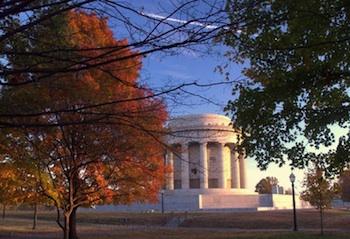On a warm, early fall day with brilliant sunshine and the Wabash River glistening as it flowed past the large limestone and granite building that locals affectionately call “The Memorial,” I stopped to visit George Rogers Clark National Historical Park.
Located in Vincennes, Indiana, the urban park honors the heroic deeds of George Rogers Clark and his men who captured the British Fort Sackville on 25 February 1779. Park rangers point out to visitors that this American Revolutionary battle helped the nation win the war and helped ensure that the Northwest Territory would be kept by the new nation when the terms of the peace treaty were negotiated in Paris.
Vincennes, settled by the French, was an important trade center during the 1700s. The Great Lakes, the Mississippi, and other rivers such as the Wabash and Illinois were used by French traders to move furs to Montreal and Quebec. Establishing good relations with the Native Americans who inhabited the region, the French built settlements along the Mississippi at Cahokia and Kaskaskia and along the Wabash at Vincennes. When the British won control of the land after the French and Indian War (1754-1763) French inhabitants continued to live in the settlements. Today, when visiting Vincennes, the French influence is found in street names and in the design of homes.
Hoping to halt settlement west of the Appalachians, the British government issued the Proclamation of 1763 but settlers continued to cross the mountains and occupy land, especially in present-day Kentucky. British military leaders at Fort Detroit encouraged Native American war parties to raid settlements and by the time of the outbreak of the American Revolution, Kentuckians were calling for assistance and asked the governor of Virginia to send a militia. This is when George Rogers Clark convinced Virginia governor Patrick Henry to allow him to lead a group of men against British strongholds at Kaskaskia and Vincennes, and hopefully march on to Detroit to break British control in the region.
In the spring of 1778 Clark and 150 men left present-day Louisville, floated down the Ohio River to a point where it joins the Mississippi, then marched overland and captured Kaskaskia and Cahokia. A few months later in February 1779, Clark learned that British Lt. Governor Henry Hamilton had taken control at Vincennes. Setting out from Kaskaskia, Clark and 170 men crossed flooded Illinois countryside and were able to surprise Fort Sackville and forced Hamilton to surrender on 25 February. The Americans were there to stay – no one would drive them from land they possessed, or hoped to possess, in this northwestern territory.
As the 150th anniversary of the American Revolution neared, citizens of Vincennes and Indiana wanted to commemorate Clark’s victory and eventually their efforts paid off when President Calvin Coolidge signed a law establishing the George Rogers Clark Sesquicentennial Commission with the purpose of constructing a permanent memorial to honor Clark and his men.
The Clark Memorial, designed by the architectural firm of Hirons and Mellor of New York is a rotunda more than 80 feet high and 180 feet across at the base. Built in classic Greek style¸ the granite exterior is encircled by 16 columns. The interior, made of limestone and marble contains a bronze statue of Clark and on the walls are seven murals that depict the story of Clark’s role in winning the Northwest Territory.
A visitor center, opened during July 1976, during the Bicentennial of the American Revolution, presents a film, exhibits, and a bookstore. The grounds are exquisitely landscaped and provide a peaceful respite for hurried travelers.
On that beautiful day, I strolled the grounds, walked along the river and contemplated the meaning of Clark’s words, “Great things have been effected by a few men well conducted.” Still a pertinent message for us today.




Comments
Thanks, Dr. Owens for introducing me to a new park unit.
I enjoy reading about small historic parks, even if I have no immediate plans to visit.
Danny